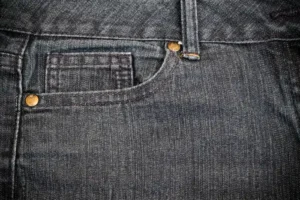Have you ever looked inside your jeans at that small, nearly useless pocket? You’re familiar with the one that’s just large enough to hold a few coins. You’re not the only one who has ever pondered its genesis. This pocket’s history goes back more than a century, despite the fact that it might appear to be a vestigial feature in today’s fashion.

In the 1890s, Levi Strauss & Co. introduced the little pocket, which most of us have probably never used for anything useful. Its original purpose was extremely specific: to house pocket watches. In those days, it was common to wear a pocket watch, which was a little but necessary piece of equipment. Over time, though, as pocket watches fell out of favor and smartphones took over, the little pocket has remained, more as a nod to history than for any practical use.
The design of these mini pockets can be traced back to 1873 when Levi Strauss and his business partner, J.W. Davis, filed a patent for “Improvement in Fastening Pocket Openings.” By 1890, the “Lot 501” jeans were born, and with them, the iconic tiny pocket made its debut. These jeans eventually evolved into the 501 jeans we know and love today.

Levi Strauss & Co. historian Tracey Panek recently spoke to Insider about the significance of the pocket. She explained, “The oldest pair of waist overalls in the Levi Strauss & Co. Archives, from 1879, includes the watch pocket.”
Interestingly, this tiny pocket isn’t found on suit trousers, as pocket watches were typically kept in the vest pocket of a formal jacket. Levi Strauss himself is said to have carried his pocket watch in the vest of his business suit.

Fast forward to today, and the pocket has become more of a nostalgic feature. While it no longer serves its original purpose, Levi’s keeps it in place to preserve the design integrity of their early jeans. According to Panek, the jeans’ design has largely remained unchanged since its inception, with a brief exception during WWII when the metal rivets were removed to conserve materials for the war effort.
It is important to note that the small pocket on Levi’s pants isn’t actually the fifth pocket. The back-left pocket, which was added in 1901, deserves that distinction. There was only one rear pocket on the right side of the original Levi’s pants from the 19th century.

Other fashion brands have embraced the little pocket idea over time, often hiding it inside a larger pocket or putting it in different locations. The pocket acts as a subliminal reminder that jeans are not appropriate for formal settings and are instead intended for casual wear.
What can you really do with the small pocket today? It has proven useful to people for carrying little objects like money, rings, matches, and even keys. So, while it may not be practical for pocket watches anymore, it certainly holds a place in fashion history.





